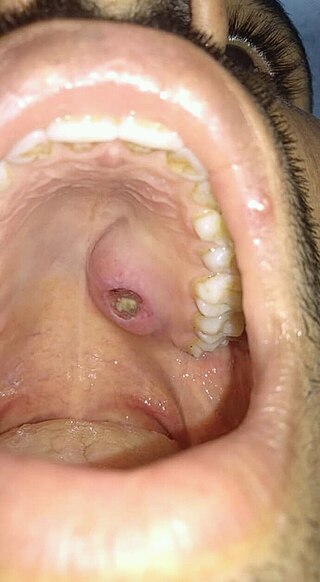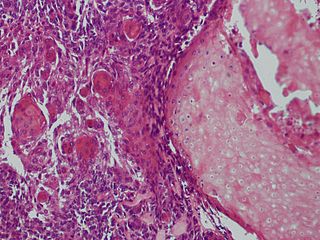Related Research Articles

Smoking cessation, usually called quitting smoking or stopping smoking, is the process of discontinuing tobacco smoking. Tobacco smoke contains nicotine, which is addictive and can cause dependence. As a result, nicotine withdrawal often makes the process of quitting difficult.

The hard palate is a thin horizontal bony plate made up of two bones of the facial skeleton, located in the roof of the mouth. The bones are the palatine process of the maxilla and the horizontal plate of palatine bone. The hard palate spans the alveolar arch formed by the alveolar process that holds the upper teeth.

Oral leukoplakia is a potentially malignant disorder affecting the oral mucosa. It is defined as "essentially an oral mucosal white lesion that cannot be considered as any other definable lesion." Oral leukoplakia is a white patch or plaque that develops in the oral cavity and is strongly associated with smoking. Leukoplakia is a firmly attached white patch on a mucous membrane which is associated with increased risk of cancer. The edges of the lesion are typically abrupt and the lesion changes with time. Advanced forms may develop red patches. There are generally no other symptoms. It usually occurs within the mouth, although sometimes mucosa in other parts of the gastrointestinal tract, urinary tract, or genitals may be affected.

Stomatitis is inflammation of the mouth and lips. It refers to any inflammatory process affecting the mucous membranes of the mouth and lips, with or without oral ulceration.
Dipping tobacco is a type of finely ground or shredded, moistened smokeless tobacco product. It is commonly and idiomatically known as "dip". Dipping tobacco is used by placing a pinch, or "dip", of tobacco between the lip and the gum. The act of using it is called dipping. Dip is colloquially called "chaw", "snuff", "rub", or "fresh leaf" among other terms; because of this, it is sometimes confused with other tobacco products—namely nasal/dry snuff.

Tobacco products, especially when smoked or used orally, have negative effects on human health. Researchers have addressed concerns about these effects for a long time. They have focused primarily on cigarette smoking.
Inflammatory papillary hyperplasia (IPH) is a benign lesion of the oral mucosa which is characterized by the growth of one or more nodular lesions, measuring about 2mm or less. The lesion almost exclusively involves the hard palate, and in rare instances, it also has been seen on the mandible. The lesion is mostly asymptomatic and color of the mucosa may vary from pink to red.

Verrucous carcinoma (VC) is an uncommon variant of squamous cell carcinoma. This form of cancer is often seen in those who chew tobacco or use snuff orally, so much so that it is sometimes referred to as "Snuff dipper's cancer".
Stomatitis nicotina is a diffuse white patch on the hard palate, usually caused by tobacco smoking, usually pipe or cigar smoking. It is painless, and it is caused by a response of the palatal oral mucosa to chronic heat. A more pronounced appearance can occur with reverse smoking, sometimes distinguished from stomatitis nicotina by the term reverse smoker's stomatitis. While stomatitis nicotina that is caused by heat is not a premalignant condition, the condition that is caused by reverse smoking is premalignant.

Necrotizing sialometaplasia (NS) is a benign, ulcerative lesion, usually located towards the back of the hard palate. It is thought to be caused by ischemic necrosis of minor salivary glands in response to trauma. Often painless, the condition is self-limiting and should heal in 6–10 weeks.
Giant-cell fibroma is a benign localized fibrous mass. It often mimics other fibroepithelial growths and can be distinguished by its histopathology. The exact cause of giant-cell fibromas is unknown however there is no evidence to show that it can be caused by irritation. Giant-cell fibromas can be removed by surgical incision, electrosurgery, or laser excision.
Leukoedema is a blue, grey or white appearance of mucosae, particularly the buccal mucosa ; it may also occur on the mucosa of the larynx or vagina. It is a harmless and very common condition. Because it is so common, it has been argued that it may in fact represent a variation of the normal appearance rather than a disease, but empirical evidence suggests that leukoedema is an acquired condition caused by local irritation. It is found more commonly in black skinned people and tobacco users. The term is derived from the Greek words λευκός leukós, "white" and οἴδημα oídēma, "swelling".
Median palatal cysts are uncommon hard palate fissural cysts that are not odontogenic. These lesions are located behind the incisive canal in the midline of the hard palate. The majority of the time, median palatine cysts are asymptomatic and are discovered by coincidence while a patient is being evaluated for a different ailment.

Smoking is a practice in which a substance is combusted and the resulting smoke is typically inhaled to be tasted and absorbed into the bloodstream of a person. Most commonly, the substance used is the dried leaves of the tobacco plant, which have been rolled with a small rectangle of paper into an elongated cylinder called a cigarette. Other forms of smoking include the use of a smoking pipe or a bong.

Smoker's melanosis is seen with the naked eye as a brown to black pigmentation of the oral tissue i.e. the gums, cheeks or palate as well as in larynx. It is most often seen in the lower labial gingiva of tobacco users. Most easily it is found in Caucasians, due to their lack of a genetically caused melanin pigmentation.
Gum depigmentation, also known as gum bleaching, is a procedure used in cosmetic dentistry to lighten or remove black spots or patches on the gums consisting of melanin. Melanin in skin is very common in inhabitants in many parts of the world due to genetic factors. Melanin pigmentation in skin, oral mucosa, inner ear and other organs is a detoxification mechanism. Some toxic agents bind to melanin and will move out of the tissue with the ageing cells and are expelled to the tissue surfaces. Also in the gums and oral mucosa a visible pigmentation is most often caused by genetic factors, but also by tobacco smoking or in a few cases by long-term use of certain medications. If stopping smoking or change of medication do not solve the problem with a disfigurating melanin pigmentation, a surgical operation may be performed. The procedure itself can involve laser ablation techniques.
Oral and maxillofacial pathology refers to the diseases of the mouth, jaws and related structures such as salivary glands, temporomandibular joints, facial muscles and perioral skin. The mouth is an important organ with many different functions. It is also prone to a variety of medical and dental disorders.

Malignant pilomatricoma is a cutaneous condition characterized by a locally aggressive tumor composed of hair-matrix cells.
Oral pigmentation is asymptomatic and does not usually cause any alteration to the texture or thickness of the affected area. The colour can be uniform or speckled and can appear solitary or as multiple lesions. Depending on the site, depth, and quantity of pigment, the appearance can vary considerably.
The ameloblastic fibro-odontoma (AFO) is essentially a benign tumor with the features characteristic of ameloblastic fibroma along with enamel and dentin. Though it is generally regarded as benign, there have been cases of its malignant transformation into ameloblastic fibrosarcoma and odontogenic sarcoma. Cahn LR and Blum T, believed in "maturation theory", which suggested that AFO was an intermediate stage and eventually developed during the period of tooth formation to a complex odontoma thus, being a hamartoma.
References
- ↑ Pindborg, Jens J.; Daftary, Dinesh K.; Mehta, Fali S. (1977). "A follow-up study of sixty-one oral dysplastic precancerous lesions in Indian villagers". Oral Surgery, Oral Medicine, Oral Pathology. 43 (3): 383–90. doi:10.1016/0030-4220(77)90325-5. PMID 265042.
- ↑ Higgins, Stephen T.; Kurti, Allison N.; Redner, Ryan; White, Thomas J.; Gaalema, Diann E.; Roberts, Megan E.; Doogan, Nathan J.; Tidey, Jennifer W.; Miller, Mollie E.; Stanton, Cassandra A.; Henningfield, Jack E.; Atwood, Gary S. (2015-11-01). "A literature review on prevalence of gender differences and intersections with other vulnerabilities to tobacco use in the United States, 2004-2014". Preventive Medicine. 80: 89–100. doi:10.1016/j.ypmed.2015.06.009. ISSN 1096-0260. PMC 4592404 . PMID 26123717.
- ↑ Dharmavaram, Ayesha Thabusum; Nallakunta, Rajesh; Reddy, Sudhakara Reddy; Chennoju, Sai Kiran (2016-04-01). "Demystifying the Enigma of Smoking – An Observational Comparative Study on Tobacco Smoking". Journal of Clinical and Diagnostic Research : JCDR. 10 (4): ZC94–ZC99. doi:10.7860/JCDR/2016/16359.7677. ISSN 2249-782X. PMC 4866260 . PMID 27190962.
- ↑ Gupta, P C; Mehta, F S; Pindborg, J J (1984-10-06). "Mortality among reverse chutta smokers in south India". British Medical Journal (Clinical Research Ed.). 289 (6449): 865–866. doi:10.1136/bmj.289.6449.865. ISSN 0267-0623. PMC 1443430 . PMID 6434115.
- ↑ Bharath, Tsreenivasa; Kumar, Ngovind Raj; Nagaraja, A; Saraswathi, TR; Babu, Gsuresh; Raju, Pramanjaneya (2015). "Palatal changes of reverse smokers in a rural coastal Andhra population with review of literature". Journal of Oral and Maxillofacial Pathology. 19 (2): 182–7. doi: 10.4103/0973-029X.164530 . PMC 4611926 . PMID 26604494.
- ↑ Werning, John W. (2007). Oral Cancer: Diagnosis, Management, and Rehabilitation. Thieme. ISBN 978-3-13-135811-0.
- ↑ Hedin, C. a; Pindborg, J. J.; Daftary, D. K.; Mehta, F. S. (1992-11-01). "Melanin depigmentation of the palatal mucosa in reverse smokers: a preliminary study". Journal of Oral Pathology & Medicine. 21 (10): 440–444. doi:10.1111/j.1600-0714.1992.tb00971.x. ISSN 0904-2512. PMID 1460582.
- ↑ John, Hussain Ali S; Dakhale, Rishika; Sedani, Shweta; Ahuja, Kajal P (2023). "Smoker's Palate: An Often Misunderstood Benign Lesion of the Oral Cavity". Cureus. 15 (11): e48868. doi: 10.7759/cureus.48868 . ISSN 2168-8184. PMC 10724502 . PMID 38106782.